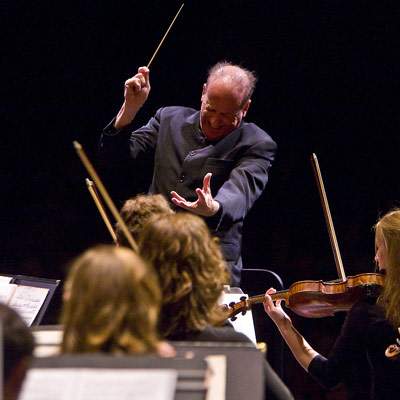Academy Festival Orchestra Opens Season at the Granada
Music Academy of the West Festival Orchestra Premiered with Ravel, Shostakovich

The opening night of the Music Academy’s Festival Orchestra series is one of the jewels of any Santa Barbara musical year, and no choice for its opening concert could have been more apt than Maurice Ravel’s “Suite No. 2” from the ballet Daphnis et Chloe. It begins with lovers finding each other in a garden at daybreak. The feeling of being outdoors in early sunshine, with running water nearby, and awakening life blooming all around is replicated in a glorious cloud of sound. Later, when Chloe performs her dance in praise of Pan, the flutes join in a wild chorus. Conductor Larry Rachleff signaled his approval by bringing the flute section-Martha Long, Aaron Perdue, Matthew Roitstein, and Elise Shope-to their feet first during the ovation that followed the 17-minute piece.
After the interval, the Symphony No. 5 of Dmitri Shostakovich successfully defended its crown as the greatest symphony of the 20th century. Written under extraordinary duress at the height of Shostakovich’s scrutiny by Stalin for politically incorrect tendencies, the work has come to embody, through its complex and still evolving reception and performance history, the highest intellectual aspirations of modern music. At once a capitulation and a protest, Shostakovich’s Symphony No. 5 managed to miraculously save the composer from what seemed an almost certain fate as an early victim of Stalin’s purges. At the same time, it reveals a perceptibly equivocal attitude toward the heroism of the Soviet system that it initially was understood to glorify.
To whatever extent the history associated with this extraordinary work was present to the young members of the orchestra on Saturday, they certainly all rose to the occasion as performers of this vast, dark, and immensely moving spectacle. Again the flutes were called out, as were the brass, woodwinds, and percussion. Rachleff, who was his usual dynamic self all night, was particularly spellbinding during the magical “Largo” movement. For all the apparent tradition and relative safety of so-called classical music, of which this symphony most definitely is an example, there also is something dramatically subversive and daring about sailing this enigmatic leviathan of Soviet art through the seas of a new century.



